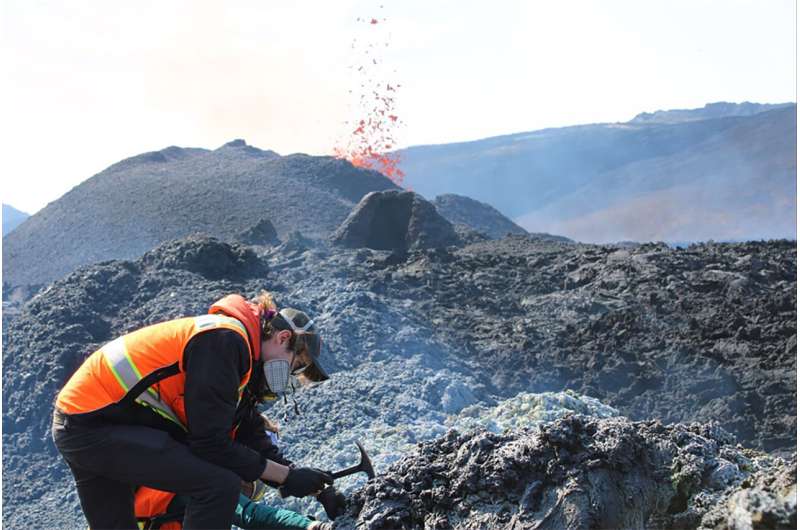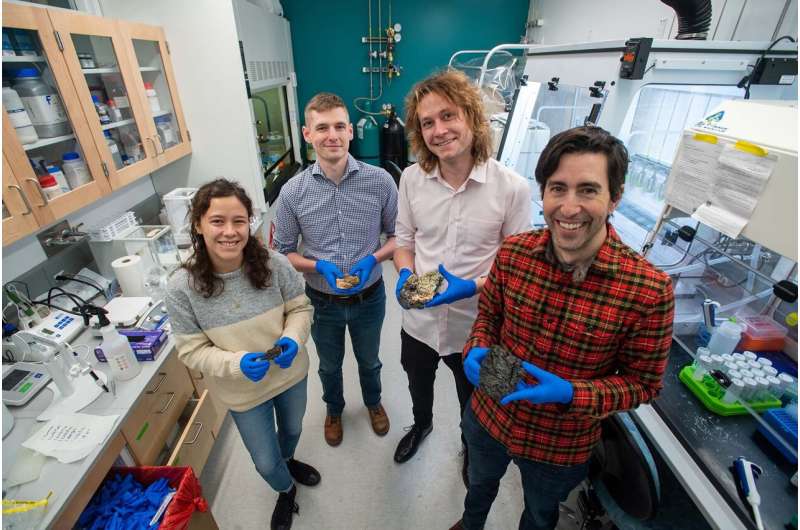
Iceland’s Fagradalsfjall volcano erupted in 2021, and again in August 2022, giving scientists like those in BU biologist Jeffrey Marlow’s lab—including PhD student Peter Schroedl (foreground)—the perfect opportunity to conduct research on the beginning of microbial life. Credit: Peter Schroedl
Microbes are just about everywhere, from the soil to the air to Arctic ice to oceans, lakes, and rivers—not to mention all over your body and the phone or computer you’re using right now.
“It’s rare to find a place where there are no microbes,” says Jeffrey J. Marlow, a Boston University College of Arts & Sciences assistant professor of biology. But there are exceptions: extreme environments—hot molten lava, boiling water jetting from deep sea vents—where the absence of microbes gives Marlow and his team an opportunity to study how these organisms survive and change over time. How long, for example, does it take for microbes to inhabit a cooling piece of molten rock, and where do they even come from?
Microbes—single-celled organisms like bacteria and archaea—help sustain life on Earth, driving nutrient cycles, breaking down organic matter and chemicals, and producing oxygen. They can cause infections, too, but the vast majority are neutral. Understanding these invisible yet indispensable communities can help scientists unlock the origins of life on Earth—the oldest fossil records, dating back 3.5 billion years, are traces of microbes—and serve as a guide for finding life on other planets.
“Life permeates the Earth, quickly altering new habitats. However, the details of how and how quickly microbes take control of new environments has never been observed over sustained intervals of time,” says Peter Schroedl, a Ph.D. student in BU’s Program in Ecology, Behavior & Evolution who works in Marlow’s lab.
Respecting an active volcano
Over the past year, Marlow, Schroedl, and other lab members have been laying the groundwork for a project documenting microbial habitation on newly formed rock. They traveled, along with students Erin Frates and Dylan Mankel, to one of the most extreme environments in the world: an active volcano.
In 2021, a new volcanic eruption began in Iceland’s Fagradalsfjall volcano after 781 years of dormancy. And then, it erupted again in August 2022. Locals and tourists all rushed to the scene to take epic photos, of course. But for researchers, this presented a rare opportunity to collect fresh rock samples, and get a close look at the molten insides of our planet. Marlow and his team of students went to the volcano site just weeks before the second eruption, when the land was still hot and lava was still trickling underground from the first one.
“Jeff took a piece of rock that we were sampling, put it in a bag, and the bag started to melt,” Frates says. She is a second-year Ph.D. student who studies microbial diversity and their metabolic activity in Marlow’s lab. She and her teammates traversed the edge of the lava field away from tourists, chiseling off pieces of hardened basaltic rock.

Erin Frates, Dylan Mankel, Peter Schroedl, and Jeffrey Marlow in the lab holding pieces of igneous rock collected from Fagradalsfjall, Iceland. Credit: Cydney Scott
In the week they were there, the team collected samples, incubated and preserved them, and brought them back to Boston—all while ensuring they didn’t become contaminated.
Once lava cools and hardens into a rock, microbes can move in—but how long does that take? And who are they? Where do they come from? Marlow and his team are looking to see what type of microbial communities appear, and ultimately, what particular environmental and biological factors set a chunk of volcanic rock on the path toward becoming a forest or another developed ecosystem.
“The fact that life could, and actively does, conduct chemical reactions on its own is amazing; it seems like magic,” says Frates. “Microbes are tiny chemists.”
In the past, researchers have found that it takes less than four months for microbes to move into a newly formed rock, Marlow says, but the specifics beyond that have not been well documented. In the lab, the rocks, which shimmer with speckles of green and blue, are awaiting DNA and mineral composition analysis. This will clarify which microbes were present at the time the rocks were found, 10 months after their formation. The team also has samples just days or weeks old, thanks to a partnership with collaborator Solange Duhamel at the University of Arizona. The researchers plan to return to the volcano to take another batch of samples to see how the microbial community has changed in the year since they visited.
“Our work provides an opportunity to discern how microbes wrest control of an abiotic environment, using a continuing volcanic eruption as an ideal natural laboratory,” Schroedl says. He stayed in the weeks after Marlow’s group left to continue doing research with NASA’s RAVEN project, which tests drones in Iceland’s lava fields for future Mars exploration. He was there to witness Fagradalsfjall roar to life after more than a year of inactivity, and took the opportunity to collect additional samples.
“Roaring is no exaggeration,” Schroedl says. “It is a rare privilege to get up close and personal with an erupting volcano, respecting the volcano and honoring that rarity was personally of the utmost importance.”
Underwater chemistry
Just weeks after trekking around the Icelandic volcano, Marlow threw himself into another extreme environment. That same summer, he ventured more than 5,000 meters below the Caribbean Sea aboard the Woods Hole Oceanographic Institution’s Alvin submersible, which had recently reached historic depths of 6,500 meters. Marlow attended a two-week-long cruise with scientists from across the world to test the submersible’s scientific capabilities. He also collected samples from the Mid-Cayman Spreading Center, an area of mid-ocean ridges where two tectonic plates are slowly separating and material is spewing from the interior, making it a hot spot of hydrothermal vents.

The rocks are preserved in their natural state in order to gather accurate DNA information about any microbial life that could be present. This will give the researchers clues about when the microbes inhabited the rock after it hardened, and where they might have come from. Credit: Cydney Scott
Scientists believe that hydrothermal vents—which are basically underwater volcanoes—were a breeding ground for the earliest microbes. These vents are a cocktail of chemicals, sediments, and hot liquid from deep in the Earth mixing with cool ocean water—vent fluid can be 400 degrees Celsius, and the seawater only 4 degrees C, resulting in huge temperature differences in the span of just a few inches. Marlow wants to find the threshold where microbes can survive in such conditions.
During his time in the sub, he examined the watery depths for new tectonic activity, while other dives retrieved chunks of hydrothermal vent chimneys, largely composed of copper, sulfur, and other metals.
Back in a lab, Marlow mixed raw materials—like carbon, nitrogen, or amino acids—with the sample material to track the microbes eating and breaking down the added components, giving clues to the microbial abundance and activity. For now, the vent sample is sealed and waiting to be studied. He is particularly interested in microbes that metabolize methane, called anaerobic methanotrophs. In a 2021 paper, Marlow and a team of scientists studied four different marine methane seeps, which is where methane gas leaks from seafloor sediments, in the Gulf of Mexico, the US Atlantic Margin, the Guaymas Basin, and off the California coast. They found that previous studies had vastly underestimated the rock-based methanotrophs’ methane consumption.
“Methane is a very strong greenhouse gas, and there are aquatic microbes that eat the methane before it gets to the surface,” Marlow says. About 80 percent of methane released underwater gets gobbled up by microbes, he says, saving that gas from ever reaching the atmosphere.
“Microbes are the world’s premier chemists, and when we work with them, we can accomplish truly spectacular feats,” says Schroedl. If it weren’t for a 1966 discovery, we wouldn’t have COVID-19 tests, which use an enzyme first discovered in a heat-resistant microorganism found at a Yellowstone lake. When it comes to reducing greenhouse gas emissions, Marlow believes methanotrophs could potentially be studied as a way to sequester and regulate methane gas.
Beyond our own planet, scientists are using microbes found in extreme environments as templates for finding single-celled life on other planets and moons—since deserts, volcanoes, and seafloor vents are the most analogous places we have to Mars and Saturn’s biggest moon, Titan. This is broadly called astrobiology, a field that seeks to find possible extraterrestrial life by studying Earth’s systems. By continuing the hunt for early microbes in the most harsh places, Marlow and his team hope to contribute more to understanding life here—and beyond.
“What is happening, even when it seems out of sight, is still directly impacting the whole planet,” Frates says. “There’s inherent value in exploration.”








